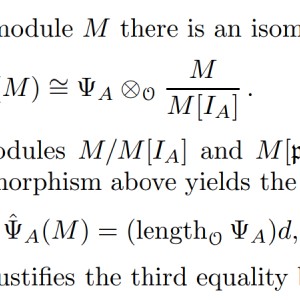Module isomorphism and length of tensor product.
See image: Why is the isomorphism of $\Psi_A$ modules true and how do we show the length equality? Notation: $A$ is a commutative, Noetherian, local ring together with a surjective homomorphism to a discrete valuation ring: $\lambda: A \rightarrow \mathcal{O} , p_A=ker(\lambda), I_A= Ann[p_A]$ (the annihilator of the kernel of the map), $\Psi_A=\mathcal{O}/\lambda(I_A), M[I]=\{m \in M: mi=0, \forall i \in I\}$ (for every ideal $I$ of $A$), $\hat{\Psi}_A= \frac{M}{M[I_A]+I_AM}$. Please let me know if you need to know any more facts.
 Jbuck
Jbuck
152
Answer
Answers can only be viewed under the following conditions:
- The questioner was satisfied with and accepted the answer, or
- The answer was evaluated as being 100% correct by the judge.
 Dynkin
Dynkin
779
The answer is accepted.
Join Matchmaticians Affiliate Marketing
Program to earn up to a 50% commission on every question that your affiliated users ask or answer.
- answered
- 1484 views
- $30.00
Related Questions
- Find an expression for the total area of the figure expressed by x.
- Need Upper Bound of an Integral
- Reverse this equation/function (2d to isometric)
- Would the Equation $s⋅G=P1+e⋅P2$ Reveal Hidden Points $P1$ and $P2$ on an Elliptic Curve?
- A word problem about a rectangular carpet
- Representation theory 2 questions
- Tensor Product II
- What is f(x). I've been trying to understand it for so long, but I always get different answers, I feel like I'm going crazy. Please someone explain it and read my whole question carefully.

